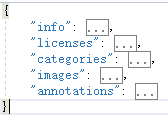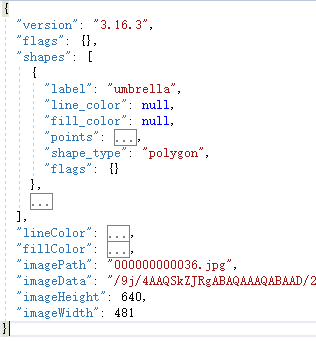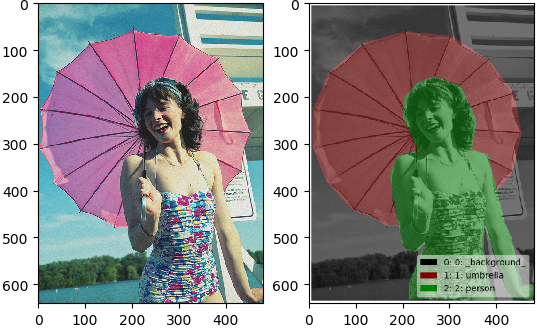coco标注信息与labelme标注信息的详解、相互转换及可视化
引言
在做实例分割或语义分割的时候,我们通常要用labelme进行标注,labelme标注的json文件与coco数据集已经标注好的json文件的格式和内容有差异。如果要用coco数据集的信息,就要对json文件进行修改和转换。本博客提供两种格式的具体内容及含义以及两种格式相互转换的代码,并对两种格式的json标注信息进行可视化。
1.coco格式的json标注信息详解及可视化
从coco官网下载coco的数据集里面,关于实例的标注信息在“annotations_trainval2017.zip”压缩文件里面的“instances_train2017.json”和“instances_val2017.json”里面,分别是训练集和验证集的标注信息。
下载地址:
训练集图片:http://images.cocodataset.org/zips/train2017.zip
验证集图片:http://images.cocodataset.org/zips/val2017.zip
测试集图片:http://images.cocodataset.org/zips/test2017.zip
训练集、验证集标注信息:http://images.cocodataset.org/annotations/annotations_trainval2017.zip
http://images.cocodataset.org/annotations/stuff_annotations_trainval2017.zip
http://images.cocodataset.org/annotations/panoptic_annotations_trainval2017.zip
由于“instances_train2017.json”里面把所有训练集图片的标注信息整合到一个文件了,文件非常大,不太好查看内部具体内容。我从这个文件中提取出一张图片的信息保存成一个新的json文件。
json文件内主要字段:

代码如下:
# -*- coding: utf-8 -*-
from __future__ import print_function
"""
Created on Thu Aug 15 13:58:40 2019 @author: Taoting
""" '''
从coco的标注文件里提取一张图片对应的json信息,并保存成新的json文件(以instance为例,其他的类似)。
'''
import matplotlib.pyplot as plt
import os, sys, zipfile
import urllib.request
import shutil
import numpy as np
import skimage.io as io
import pylab
import json
from pycocotools.coco import COCO pylab.rcParams['figure.figsize'] = (8.0, 10.0) json_file='../../../coco dataset/annotations_trainval2017/instances_val2017.json' # # Object Instance 类型的标注
# json_file='./annotations/person_keypoints_val2017.json' # Object Keypoint 类型的标注格式
# json_file='./annotations/captions_val2017.json' # Image Caption的标注格式 data=json.load(open(json_file,'r')) data_2={}
data_2['info']=data['info']
data_2['licenses']=data['licenses']
data_2['images']=[data['images'][0]] # 只提取第一张图片
data_2['categories']=data['categories']
annotation=[] # 通过imgID 找到其所有instance
imgID=data_2['images'][0]['id']
#print(imgID)#397133
# initialize COCO api for instance annotations
coco=COCO(json_file)
img = coco.loadImgs([imgID])
#print(img)#[{'license': 4, 'file_name': '000000397133.jpg', 'coco_url': 'http://images.cocodataset.org/val2017/000000397133.jpg',
# 'height': 427, 'width': 640, 'date_captured': '2013-11-14 17:02:52', 'flickr_url': 'http://farm7.staticflickr.com/6116/6255196340_da26cf2c9e_z.jpg', 'id': 397133}]
#print(img['file_name'])
# load and display image
I = io.imread('../../../coco dataset/val2017/%s' % img[0]['file_name'])
# use url to load image
#I = io.imread(img['coco_url'])
#plt.axis('off')
#plt.imshow(I)
#plt.show() for ann in data['annotations']:
if ann['image_id']==imgID:
annotation.append(ann) data_2['annotations']=annotation # 保存到新的json
json.dump(data_2,open('./{}.json'.format(str(img[0]['file_name']).split('.')[0]),'w'),indent=4)
从coco标注json中提取单张图片的标注信息
得到一张图片的标注信息如下,包含5大部分的字段信息。
"info"的value是一个dict,存储数据集的一些基本信息,我们不需要关注;
"licenses"的value是一个list,存储license信息,我们不需要关注;
"categories"的value是一个list,存储数据集的类别信息,包括类别的超类、类别id、类别名称;
“images”的value是一个list,存储这张图片的基本信息,包括图片名、长、宽、id等重要信息;
"annotations"的value是一个list,存储这张图片的标注信息,非常重要,list中的每一个元素是一个dict,也即一个标注对象(instance)的信息。包括的字段有"segmentation":标注点的坐标,从第一个的x,y坐标一直到最后一个点的x,y坐标;"area"是标注的闭合多边形的面积; "iscrowd"表示对象之间是否有重叠;"image_id"是图片的id;“bbox”是instance的边界框的左上角的x,y,边界框的宽和高;"category_id"是这个instance对应的类别id;"id"表示此instance标注信息在所有instance标注信息中的id。
{
"info": {
"description": "COCO 2017 Dataset",
"url": "http://cocodataset.org",
"version": "1.0",
"year": 2017,
"contributor": "COCO Consortium",
"date_created": "2017/09/01"
},
"licenses": [
{
"url": "http://creativecommons.org/licenses/by-nc-sa/2.0/",
"id": 1,
"name": "Attribution-NonCommercial-ShareAlike License"
},
{
"url": "http://creativecommons.org/licenses/by-nc/2.0/",
"id": 2,
"name": "Attribution-NonCommercial License"
},
...(太长,省略)
],
"categories": [
{
"supercategory": "person",
"id": 1,
"name": "person"
},
...(太长,省略)
],
"images": [
{
"license": 2,
"file_name": "000000000049.jpg",
"coco_url": "http://images.cocodataset.org/train2017/000000000049.jpg",
"height": 500,
"width": 381,
"date_captured": "2013-11-14 20:00:23",
"flickr_url": "http://farm4.staticflickr.com/3250/2883102207_bcba5527a7_z.jpg",
"id": 49
}
],
"annotations": [
{
"segmentation": [
[
181.59,
363.43,
...(太长,省略)
]
],
"area": 8451.22405,
"iscrowd": 0,
"image_id": 49,
"bbox": [
162.57,
226.56,
130.41,
184.43
],
"category_id": 19,
"id": 56407
},
...(太长,省略)
]
}
我们对这个新coco格式的json文件进行可视化:
# -*- coding: utf-8 -*-
"""
Created on Thu Aug 15 14:48:12 2019 @author: Taoting
"""
from __future__ import print_function
import matplotlib.pyplot as plt
# ~ from pycocotools.coco import COCO
from coco import COCO
import os, sys, zipfile
import urllib.request
import shutil
import numpy as np
import skimage.io as io
import pylab
pylab.rcParams['figure.figsize'] = (8.0, 10.0) annFile='./modified_satisfied_json_train2017/000000000149.json'#json文件路径
coco=COCO(annFile) cats = coco.loadCats(coco.getCatIds())
nms=[cat['name'] for cat in cats] nms = set([cat['supercategory'] for cat in cats]) imgIds = coco.getImgIds()
img = coco.loadImgs(imgIds[0])[0]
dataType = './satisfied_images_train2017'
I = io.imread('%s/%s'%(dataType,img['file_name'])) plt.axis('off')
plt.imshow(I)
plt.show() # 加载和可视化instance标注信息
catIds=[]
for ann in coco.dataset['annotations']:
if ann['image_id']==imgIds[0]:
catIds.append(ann['category_id']) plt.imshow(I); plt.axis('off')
annIds = coco.getAnnIds(imgIds=img['id'], catIds=catIds, iscrowd=None)
anns = coco.loadAnns(annIds)
coco.showAnns(anns)
plt.show()
coco格式的json文件可视化instance的mask
可视化结果如下:

2.labelme格式的json标注信息详解及可视化
labelme标注工具标注的json格式与coco的格式有差异:

重点关注的是:
"shapes":存储标注instance的闭合多边形的信息,重点关注:label:类别名称;points:闭合多边形的每个点的x,y坐标;
"line_color":闭合多边形的边界线颜色;
"fill_color":闭合多边形的填充颜色;
"imagePath":图片名称;
"imageData":图片路径(加密后);
"imageHeight":图片高;
"imageWidth":图片宽;
利用labelme提供的接口将标注好的json进行可视化代码:
# -*- coding:utf-8 -*-
"""
@author: Taoting
将用labeime标注格式的json进行可视化
"""
import json
import matplotlib.pyplot as plt
import skimage.io as io
from labelme import utils def main():
json_path = './PATH/TO/JSON'
data = json.load(open(json_path))
img = io.imread('%s/%s'%('./PATH/TO/IMAGE',data['imagePath']))
lab, lab_names = utils.labelme_shapes_to_label(img.shape, data['shapes'])
captions = ['%d: %s' % (l, name) for l, name in enumerate(lab_names)]
lab_ok = utils.draw_label(lab, img, captions) plt.subplot(121)
plt.imshow(img)
plt.subplot(122)
plt.imshow(lab_ok)
plt.show() if __name__ == '__main__':
main()
可视化结果:

可以看到右图中的mask的可视化效果
结合1和2中的两种格式的json,我们只需要针对格式的差异对json文件做修改,就能将格式进行互相转换。
3.coco格式的json转labelme格式的json
直接上代码:
# -*- coding: utf-8 -*-
"""
@author: Taoting
将用coco格式的json转化成labeime标注格式的json
""" import json
import cv2
import numpy as np
import os #用一个labelme格式的json作为参考,因为很多信息都是相同的,不需要修改。
def reference_labelme_json():
ref_json_path = 'reference_labelme.json'
data=json.load(open(ref_json_path))
return data def labelme_shapes(data,data_ref):
shapes = []
label_num = {'person':0,'bicycle':0,'car':0,'motorcycle':0,'bus':0,'train':0,'truck':0}#根据你的数据来修改
for ann in data['annotations']:
shape = {}
class_name = [i['name'] for i in data['categories'] if i['id'] == ann['category_id']]
#label要对应每一类从_1开始编号
label_num[class_name[0]] += 1
shape['label'] = class_name[0] + '_' + str(label_num[class_name[0]])
shape['line_color'] = data_ref['shapes'][0]['line_color']
shape['fill_color'] = data_ref['shapes'][0]['fill_color'] shape['points'] = []
# ~ print(ann['segmentation'])
if not type(ann['segmentation']) == list:
continue
else:
x = ann['segmentation'][0][::2]#奇数个是x的坐标
y = ann['segmentation'][0][1::2]#偶数个是y的坐标
for j in range(len(x)):
shape['points'].append([x[j], y[j]]) shape['shape_type'] = data_ref['shapes'][0]['shape_type']
shape['flags'] = data_ref['shapes'][0]['flags']
shapes.append(shape)
return shapes def Coco2labelme(json_path,data_ref):
with open(json_path,'r') as fp:
data = json.load(fp) # 加载json文件
data_labelme={}
data_labelme['version'] = data_ref['version']
data_labelme['flags'] = data_ref['flags'] data_labelme['shapes'] = labelme_shapes(data,data_ref) data_labelme['lineColor'] = data_ref['lineColor']
data_labelme['fillColor'] = data_ref['fillColor']
data_labelme['imagePath'] = data['images'][0]['file_name'] data_labelme['imageData'] = None
# ~ data_labelme['imageData'] = data_ref['imageData'] data_labelme['imageHeight'] = data['images'][0]['height']
data_labelme['imageWidth'] = data['images'][0]['width'] return data_labelme if __name__ == '__main__':
root_dir = './ROOT DIR'
json_list = os.listdir(root_dir)
#参考的json
data_ref = reference_labelme_json() for json_path in json_list:
if json_path.split('.')[-1] == 'json':
print('当前文件: ', json_path)
data_labelme= Coco2labelme(os.path.join(root_dir,json_path), data_ref)
file_name = data_labelme['imagePath']
# 保存json文件
json.dump(data_labelme,open('./PATH/%s.json' % file_name.split('.')[0],'w'),indent=4)
用2中的可视化代码检验是否正确转换。
4.labelme格式的json转coco格式的json
直接上代码:
# -*- coding: utf-8 -*-
"""Created on Thu Aug 15 15:05:56 2019
@author: Taoting
将用labeime标注的json转化成coco格式的json
""" import json
import cv2
import numpy as np
import os #用闭包实现计数器
def counter():
cnt = 1000000
def increce():
nonlocal cnt
x = cnt
cnt += 1
return x
return increce def p_images(data,data_coco):
images=[]
image={}
file_name=data['imagePath'].split('\\')[-1]
image['file_name']=file_name
image['id']=int(file_name.split('.')[0])
image['height']=data['imageHeight']
image['width']=data['imageWidth']
img=None
images.append(image)
data_coco['images']=images
return file_name #用一个coco格式的json做参考
def modify_categories():
ref_json_path = 'reference.json'
data=json.load(open(ref_json_path))
modified_categories = []
catNms=['person','bicycle','car','motorcycle','truck','bus']#根据你的数据修改
for i,cat in enumerate(data['categories']):
if cat['name'] in catNms:
modified_categories.append(cat)
else:
pass
return modified_categories,data['info'],data['licenses'] def p_annotation(data,data_coco,cnt):
# annotations
annotations=[] for i in range(len(data['shapes'])):
annotation={}
annotation['segmentation']=[list(np.asarray(data['shapes'][i]['points']).flatten())] # data['shapes'][0]['points']
annotation['iscrowd']=0
annotation['image_id']=data_coco['images'][0]['id']
#找出标注点中的外接矩形的四个点
x = annotation['segmentation'][0][::2]#奇数个是x的坐标
y = annotation['segmentation'][0][1::2]#偶数个是y的坐标
print(x,y)
x_left = min(x)-1#往外扩展1个像素,也可以不扩展
y_left = min(y)-1
w = max(x) - min(x)+1
h = max(y) - min(y)+1
annotation['bbox']=[x_left,y_left,w,h] # [左上角x,y以及宽和高]
cat_list_dict = [cat for cat in data_coco['categories'] if cat['name'] == data['shapes'][i]['label'].split('_')[1]]#注意这里是跟标注时填类别的方式有关
annotation['category_id']=cat_list_dict[0]['id']
annotation['id'] = cnt() # 第一个对象 这个ID也不能重复,如果下一张图,id不能取1,需从1 开始往下取
#print('cnt', annotation['id'])
#print('annotation',annotation)
annotations.append(annotation)
#print('annotations',annotations)
data_coco['annotations']=annotations
#print(data_coco['annotations'])
#return data_coco def Labelme2coco(json_path,cnt):
with open(json_path,'r') as fp:
data = json.load(fp) # 加载json文件
data_coco={}
# images
file_name = p_images(data,data_coco)
# categories
modified_categories, info, p_license = modify_categories()
data_coco['categories'] = modified_categories
#print(data_coco['categories'])
# info
data_coco['info'] = info
# license
data_coco['license'] = p_license
# annotations
p_annotation(data,data_coco,cnt)
#print(data_coco['annotations'])
return data_coco,file_name if __name__ == '__main__':
root_dir = './ROOT DIR'
json_list = os.listdir(root_dir)
cnt = counter()
for json_path in json_list:
if json_path.split('.')[-1] == 'json':
data_coco,file_name = Labelme2coco(os.path.join(root_dir,json_path),cnt)
# 保存json文件
json.dump(data_coco,open('./PATH/%s.json' % file_name.split('.')[0],'w'),indent=4)
用1中的可视化代码检验是否正确转换。
coco标注信息与labelme标注信息的详解、相互转换及可视化的更多相关文章
- 【Linux 运维】查看网络连接状态信息之netstat和ss命令详解
一.netstat 常用命令详解 通过man netstat可以查看netstat的帮助信息: netstat 命令:用于显示各种网络相关信息,如网络连接,路由表,接口状态,无效连接,组播成员 等等. ...
- 一键获取linux内存、cpu、磁盘IO等信息脚本编写,及其原理详解
更多linux知识,请关注公众号:一口Linux 一.脚本 今天主要分享一个shell脚本,用来获取linux系统CPU.内存.磁盘IO等信息. #!/bin/bash # 获取要监控的本地服务器IP ...
- 百度地图Api详解之地图标注
标注概述 标注(Marker)是用来表示一个点位置的可见元素,每个标注自身都包含地理信息.比如你在西单商场位置添加了一个标注,不论地图移动.缩放,标注都会跟随一起移动,保证其始终指向正确的地理位置. ...
- HTTP协议的头信息详解
转载地址:http://blog.csdn.net/guoguo1980/article/details/2649658 HTTP(HyperTextTransferProtocol)是超文本传输协议 ...
- 【图文详解】scrapy爬虫与动态页面——爬取拉勾网职位信息(2)
上次挖了一个坑,今天终于填上了,还记得之前我们做的拉勾爬虫吗?那时我们实现了一页的爬取,今天让我们再接再厉,实现多页爬取,顺便实现职位和公司的关键词搜索功能. 之前的内容就不再介绍了,不熟悉的请一定要 ...
- linux dmesg命令参数及用法详解(linux显示开机信息命令)
linux dmesg命令参数及用法详解(linux显示开机信息命令) http://blog.csdn.net/zhongyhc/article/details/8909905 功能说明:显示开机信 ...
- yii2通过foreach循环遍历在一个用户组中取出id去另一表里查寻信息并且带着信息合并原数组信息---案例
yii2通过foreach循环遍历在一个用户组中取出id去另一表里查寻信息并且带着信息合并元数组信息---案例 public function actionRandomLists(){ //查询到了所 ...
- 网络编辑基础:对HTTP协议的头信息详解
HTTP(HyperTextTransferProtocol) 是超文本传输协议的缩写,它用于传送WWW方式的数据,关于HTTP 协议的详细内容请参 考RFC2616.HTTP协议采用了请求/响应模型 ...
- 百度地图Api之自定义标注:(获得标注的经纬度和中心经纬度即缩放度)
百度地图Api之自定义标注:(获得标注的经纬度和中心经纬度即缩放度) <%@ Page Language="C#" AutoEventWireup="true&qu ...
随机推荐
- Java NIO ByteBuffer 的使用与源码研究
一.结论 ByteBuffer 是Java NIO体系中的基础类,所有与Channel进行数据交互操作的都是以ByteBuffer作为数据的载体(即缓冲区).ByteBuffer的底层是byte数组, ...
- Linux学习(一)--VMware下Linux安装和配置
本片随便将给大家讲述linux在VM虚拟机上安装及终端的安装和配置 一.Linux介绍 Linux是一套免费使用和自由传播的类Unix操作系统,是一个基于POSIX和UNIX的多用户.多任务.支持多线 ...
- web设计_4_可扩展的行
不要指定横向页面组件的高度,要让它们能够在纵向自由扩展. 常见的包含文章正文或大段文字的区域,应该适应任何篇幅和大小的文字. 但是例如文章标题.登陆信息栏等也要考虑文字内容数量及高度的变化. 例如:下 ...
- RobotFramework_1.简介和安装
RobotFramework_1.简介与安装 *:first-child { margin-top: 0 !important; } body>*:last-child { margin-bot ...
- IIS网站服务器性能优化攻略
Windows Server自带的互联网信息服务器(Internet Information Server,IIS)是架设网站服务器的常用工具,它是一个既简单而又麻烦的东西,新手都可以使用IIS架设一 ...
- Docker 安装部署Sql Server
前言 在如今,容器化概念越来越盛行,.Net Core项目也可以跨平台部署了,那么思考下Sql Server能不能呢?当然是可以的啦.本文今天就是介绍Docker部署配置和连接Sql Server.本 ...
- Bean Validation完结篇:你必须关注的边边角角(约束级联、自定义约束、自定义校验器、国际化失败消息...)
每篇一句 没有任何技术方案会是一种银弹,任何东西都是有利弊的 相关阅读 [小家Java]深入了解数据校验:Java Bean Validation 2.0(JSR303.JSR349.JSR380)H ...
- ProcessBuilder waitFor 调用外部应用
小程序项目最初使用ffmpeg转换微信录音文件为wav格式,再交给阿里云asr识别成文字.视频音频转换最常用是ffmpeg. 1 ffmpeg -i a.mp3 b.wav 相关文章: 小程序实现语音 ...
- Git 学习笔记之(一) 使用 git gui 从github上下载代码
背景: 目前一些开源代码均在 GitHub上管理的,包括自己写的代码也可以放在上面进行管理.但问题是,当你换一台电脑,想要将你自己放在 GitHub 上的代码工程下载下来的时候,会遇到各种问题,目前可 ...
- bucket list 函数解析
cls_bucket_list 函数 librados::IoCtx index_ctx; // key - oid (for different shards if there is any) ...
